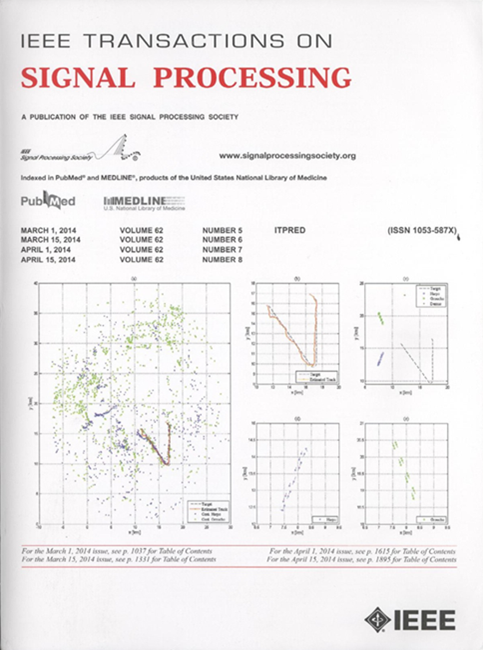带有彩色背景噪声的同地多输入多输出雷达中的一位目标检测
IF 4.6
2区 工程技术
Q1 ENGINEERING, ELECTRICAL & ELECTRONIC
引用次数: 0
摘要
在多输入多输出(MIMO)雷达系统中,单比特采样已成为一种很有前途的技术,因为它能显著减少数据量、硬件复杂性和功耗。然而,目前的检测方法还没有充分解决实际场景中经常遇到的彩色噪声的影响。在本文中,我们提出了一种在 MIMO 雷达系统中考虑彩色噪声的新型检测方法。具体来说,我们通过计算与目标反射率参数和费舍尔信息矩阵相关的似然函数导数来推导 Rao 检验,从而得到一种加权匹配滤波器形式的检测器。为了确保恒定的误报率(CFAR),我们还考虑了噪声协方差的不确定性,并研究了其对误报概率的影响。我们还对检测概率进行了分析研究。仿真结果表明,在存在彩色噪声的情况下,所提出的检测器能提供相当大的性能提升。本文章由计算机程序翻译,如有差异,请以英文原文为准。
One-Bit Target Detection in Colocated MIMO Radar With Colored Background Noise
One-bit sampling has emerged as a promising technique in multiple-input multiple-output (MIMO) radar systems due to its ability to significantly reduce data volume, hardware complexity, and power consumption. Nevertheless, current detection methods have not adequately addressed the impact of colored noise, which is frequently encountered in real scenarios. In this paper, we present a novel detection method that accounts for colored noise in MIMO radar systems. Specifically, we derive Rao's test by computing the derivative of the likelihood function with respect to the target reflectivity parameter and the Fisher information matrix, resulting in a detector that takes the form of a weighted matched filter. To ensure constant false alarm rate (CFAR), we also consider noise covariance uncertainty and examine its effect on the probability of false alarm. The detection probability is also studied analytically. Simulation results demonstrate that the proposed detector provides considerable performance gains in the presence of colored noise.
求助全文
通过发布文献求助,成功后即可免费获取论文全文。
去求助
来源期刊

IEEE Transactions on Signal Processing
工程技术-工程:电子与电气
CiteScore
11.20
自引率
9.30%
发文量
310
审稿时长
3.0 months
期刊介绍:
The IEEE Transactions on Signal Processing covers novel theory, algorithms, performance analyses and applications of techniques for the processing, understanding, learning, retrieval, mining, and extraction of information from signals. The term “signal” includes, among others, audio, video, speech, image, communication, geophysical, sonar, radar, medical and musical signals. Examples of topics of interest include, but are not limited to, information processing and the theory and application of filtering, coding, transmitting, estimating, detecting, analyzing, recognizing, synthesizing, recording, and reproducing signals.
 求助内容:
求助内容: 应助结果提醒方式:
应助结果提醒方式:


